Identification of the Last Common Ancestor of Humans and Chimpanzees
Introduction
The quest to identify the exact species that represents the last common ancestor of humans and chimpanzees is a pivotal endeavor in the field of Human Evolution. This investigation is not only significant for understanding our own evolutionary history but also sheds light on the broader picture of primate evolution. Understanding the last common ancestor can help elucidate the traits that are uniquely human, how we diverged from our closest relatives, and the evolutionary pressures that shaped both lineages. Researchers continue to employ various methodologies to uncover this ancestral lineage, making it a critical focus of evolutionary biology.
Key Concepts
Understanding Common Ancestry
The concept of a common ancestor refers to a species from which two or more species have evolved. In the case of humans and chimpanzees, molecular and fossil evidence suggests that our last common ancestor existed approximately 5 to 7 million years ago. Research indicates that analyzing DNA sequences can provide insights into the evolutionary relationships and timing of divergence.
Fossil Evidence
Fossils play a crucial role in identifying our common ancestry. Notable finds such as Sahelanthropus tchadensis and Australopithecus afarensis are often discussed as potential representatives of our mutual lineage, yet conclusive identification remains elusive.
Applications and Real-World Uses
The identification of the last common ancestor has practical applications in several fields:
- Conservation Biology: Understanding primate evolution assists in conservation efforts by highlighting genetic diversity and the ecological importance of various species.
- Medical Research: Insights gained from our evolutionary past can inform studies on disease susceptibility, particularly in genetic disorders shared with chimpanzees.
- Anthropology: Research provides evidence for cultural development through studying the cognitive traits that evolved after our divergence.
Current Challenges
Despite advances, challenges remain in accurately identifying our last common ancestor:
- Incomplete Fossil Record: The fossil record is sparse, making it difficult to pinpoint specific evolutionary pathways.
- Genetic Analysis Limitations: Although DNA analysis has progressed, it still faces challenges in extracting and interpreting ancient DNA.
- Interpretational Bias: Researchers may interpret findings through the lens of contemporary understanding, which can distort historical context.
Future Research and Innovations
Looking ahead, new technologies are set to impact how we study human evolution:
- Advanced Genomics: Innovations in genetic sequencing could reveal more information about the evolution of traits.
- Artificial Intelligence: AI can aid in the analysis of large datasets from fossil records and genetic studies.
- Interdisciplinary Approaches: Collaborations across paleontology, genetics, and anthropology are enhancing our understanding of human ancestry.
Conclusion
The ongoing efforts to identify the last common ancestor of humans and chimpanzees highlight the complexities and challenges within the field of Human Evolution. This research not only deepens our understanding of what it means to be human but also guides conservation and medical research. As technology advances, future discoveries may redefine our understanding of our ancestry. For further exploration, consider reading about theories of evolution or conservation efforts for primates.

Leave a Reply